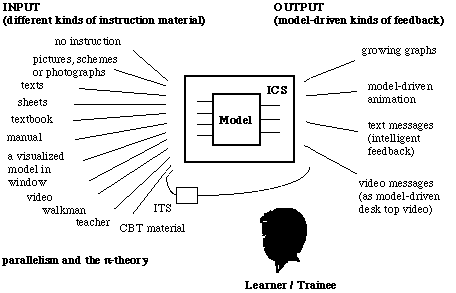The Parallel Instruction Theory
The Parallel Instruction theory explains why the cd-i has failed and web-based media are an enormous success. The Parallel Instruction theory explains why ms.dos and commandline-based computers are less important for the public and windowing computers and the desktop philosophy are so important as they are nowadays. The Parallel Instruction theory explains the approach of the modern, creative people in his/here natural habitat: secretaries with computers, students, scientific workers, writers and even children. The Parallel Instruction theory explains why voluminous reports, writen papers, fat books, news on television and even PowerPoint presentations need - parallel - explanation: live!
The 'parallel instruction theory', in short the 'PI theory', was discovered and first published by Min around 1992. In the PI theory Min and his students, assumed that a user in an open learning environment only can work and learn if the environment has been designed in such a way that all relevant information to take decisions is visible or can be immediately retrieved, because a lot of people has a problem with their short-term-memory to solve problems as they can not see all the information (Min, 1992).

Schematic scheme about parallelism on the input side and on the output side of a learning process. On the input side of a learning process you need a lot of instruction types and/or different formats (such as texts, sheets, pictures, manuals); even a walkman with a instruction tape triggers the learning process. On the output side of a learning process a lot of smart feedback keep the process going on: messages, animations, graphics until intelligent, model-driven 'text-messages' and/or 'video-messages'.
It is clear that learners in complex skills situations in e-learning environments like to have all information well-ordered and at hand as the Split Attention theory and the Cognitive Load theory indicate (Chandler & Sweller, 1996; Moreno & Mayer, 2000).
The PI-theory of Min can be described as follows: When one has to design an open learning- or working-environment, one should do everything within one's power to have all loose components within easy reach and ready for use. They should remain in the position (or state) which they have (or had) at the time. In particular the instruction, feedback, tasks, the solution room, scrapbook etc. should be parallel to the open learning environment of the (bare) simulator (with the key to the problem).
So far it is assumed that the usefulness of parallelism in open do environments is due to:
1. the user's limited short-term-memory as regards details or loose components; because the monitor always wipes out the image contents partly or entirely when the next image is shown;
2. the user wants to, must and can compare; by comparing things from the past physically to things of the present;
3. the user wants to gain insight into cause/result relations; through repeated verification and compare (with other things);
4. the user wants to create his own frame of reference and should be able to do so; by putting things that pass by on the screen side by side (by means of windows) and comparing them.
Further research will have to reveal which psychological variables and design variables play a part for the user and in the software. Also why and under which conditions the user will best develop in such an e-learning environment.
References
Min, F.B.M., (1992)
Parallel Instruction, a theory for Educational Computer Simulation. Interactive Learning Intern., Vol. 8, no. 3, 177-183.
Chandler, P., and Sweller, J. (1996)
Cognitive Load while learning to use a computer program. Appl. Cogn. Psychol. 10: 151-170.
Mayer, R. E. and R. Moreno (2000)
A split attention Effect in multimedia Learning: Evidence for Dual Processing Systems in Working Memory. J. of Educ. Psych., Vol. 90, no. 2, 312-320.
Mayer, R. E. (2001)
Multimedia learning. Cambridge University Press. ISBN 0-521-78239-2
Enschede, august 2001; updated 2004
